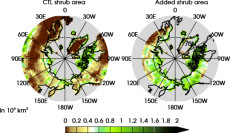Thriving Tundra Bushes Add Fuel to Northern Thaw
Spread of taller vegetation could exacerbate warming in northern latitudes
June 28, 2013
Contact: Margie Wylie, mwylie@lbl.gov, +1 510 486 7421

Left: Current deciduous shrub distribution. Right: Simulation of bare ground converted to deciduous shrubs. To enlarge, select image. (Celine Bonfils)
Carbon-gobbling plants are normally allies in the fight to slow climate change, but in the frozen north, the effects of thriving vegetation may actually push temperatures higher. In a series of climate simulations performed at NERSC, a group of researchers found that the spread of bushes, taller ones especially, could exacerbate warming in northern latitudes by anywhere from 0.6°C to 1.8°C per year.
What’s more, taller species have the potential to warm tundra soil more deeply, threatening to thaw permafrost in some areas. That means more of the greenhouse gases now locked up by a year-round freeze could be released into the atmosphere, increasing warming even more. Their results were published in Environmental Research Letters.
“Until now, most climate model studies have only focused on the climate effects induced by a complete tundra-to-forest conversion,” said Celine Bonfils, a scientist at Lawrence Livermore National Laboratory (LLNL) and principal investigator in this study. While warming could eventually lead to northward forest expansion, “we don’t expect a full-scale conversion of tundra to forest anytime in the next century,” said Tom Phillips, one of Bonfils’s collaborators on the study, also of LLNL. “More likely you’ll see shorter shrubs or new species that are taller moving in gradually.”
That is, in fact, what has been happening to some tundra regions. The authors point out that one study found a 1.2% increase per year in coverage in Alaska.
To better understand the more likely short-term fate of expanding and invading shrubs, Bonfils and colleagues simulated two, more realistic, although still idealized, scenarios: the expansion of the short shrubs that already grow on the tundra, and the invasion of taller shrubs. In both cases the team found that temperatures rose, as expected based on earlier simulations involving forest expansion, but the rise caused by taller shrubs was striking, says Phillips, a coauthor of the study.
“The physics of what’s happening here is pretty straightforward,” says Phillips. “Shrubs tend to darken the land surface, so it absorbs more sunlight, warming the ground and increasing evaporation.” Plants also suck water from the soil and transpire it into the air, a process called evapotranspiration. That water vapor, in turn, acts as a greenhouse gas, trapping heat, raising temperatures, and creating more favorable growing conditions.
“These runs, performed at NERSC, show for the first time that the strength and timing of these two mechanisms greatly depends on the height of the shrubs, and the time at which branches and leaves protrude above the snow,” explained Bonfils. Taller shrubs darken the ground earlier in the spring and transpire more efficiently than shorter shrubs, thereby increasing soil warming and making the permafrost less stable.
“These simulations mainly focus on the biophysical effects of shrub height and expansion, but they did not include the biogeochemical effects. In other words, the plants were not allowed to gobble carbon as they grow,” added Bonfils. “In expanding and growing taller, the plants will remove some greenhouse gases from the atmosphere, but probably not enough to negate the warming and permafrost destabilization induced through reduced reflection of sunlight and increased transpiration. New climate simulations would be needed to verify this hypothesis.”
About NERSC and Berkeley Lab
The National Energy Research Scientific Computing Center (NERSC) is a U.S. Department of Energy Office of Science User Facility that serves as the primary high performance computing center for scientific research sponsored by the Office of Science. Located at Lawrence Berkeley National Laboratory, NERSC serves almost 10,000 scientists at national laboratories and universities researching a wide range of problems in climate, fusion energy, materials science, physics, chemistry, computational biology, and other disciplines. Berkeley Lab is a DOE national laboratory located in Berkeley, California. It conducts unclassified scientific research and is managed by the University of California for the U.S. Department of Energy. »Learn more about computing sciences at Berkeley Lab.







